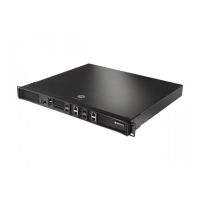Switch Management
7-27
7. Select a Radius server from the table and click the Edit button to modify how the authentication
method is used. For more information, see Modifying the Properties of an Existing Radius Server on
page 7-27.
8. Highlight a Radius Server from those listed and click the Delete button to remove the server from the
list of available servers.
9. Click the Add button at the bottom of the screen to display a sub-screen used to add a Radius Server
to the list of servers available to the switch. For more information, see
Adding a New Radius Server on page 7-28.
7.6.2.1 Modifying the Properties of an Existing Radius Server
Some of the attributes of an existing Radius Server can be modified by the switch to better reflect the Radius
Server’s existing connection with the switch.
To modify the attributes of an existing Radius Server:
1. Select Management Access > Users from the main menu tree.
The Users screen displays.
2. Select the Authentication tab.
3. Select an existing Radius Server from those listed and click the Edit button at the bottom of the
screen.
4. Modify the following Radius Server attributes as necessary:
Shared secret Displays the shared secret used to verify Radius messages (with
the exception of the Access-Request message) are sent by a
Radius-enabled device configured with the same shared secret.
The shared secret is a case-sensitive string (password) that can
include letters, numbers, or symbols. Ensure the shared secret is at
least 22 characters long to protect the Radius server from
brute-force attacks.
Retries Displays the maximum number of times the switch can retransmit
a Radius Server frame before it times out of the authentication
session.
Timeout Displays the maximum time (in seconds) the switch waits for the
Radius Server’s acknowledgment of authentication request
packets before the switch times out of the session.
Radius Server Index Displays the read-only numerical Index value for the Radius Server
to help distinguish this server from other servers with a similar
configuration (if necessary). The maximum number that can be
assigned is 32.
Radius Server IP
Address
Modify the IP address of the external Radius server (if necessary).
Ensure this address is a valid IP address and not a DNS name.
Radius Server Port Change the TCP/IP port number for the Radius Server (if necessary).
The port range available for assignment is from 1 - 65535.
Number of retries to
communicate with
Radius Server
Revise (if necessary) the maximum number of times the switch
retransmits a Radius Server frame before it times out of the
authentication session. The available range is between 0 - 100.

